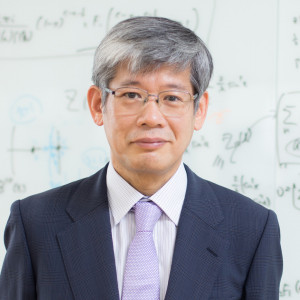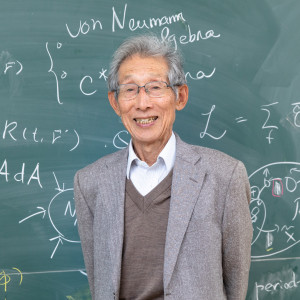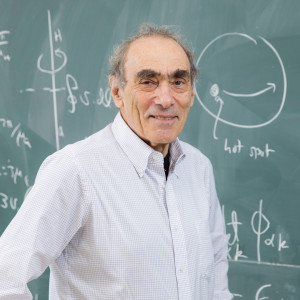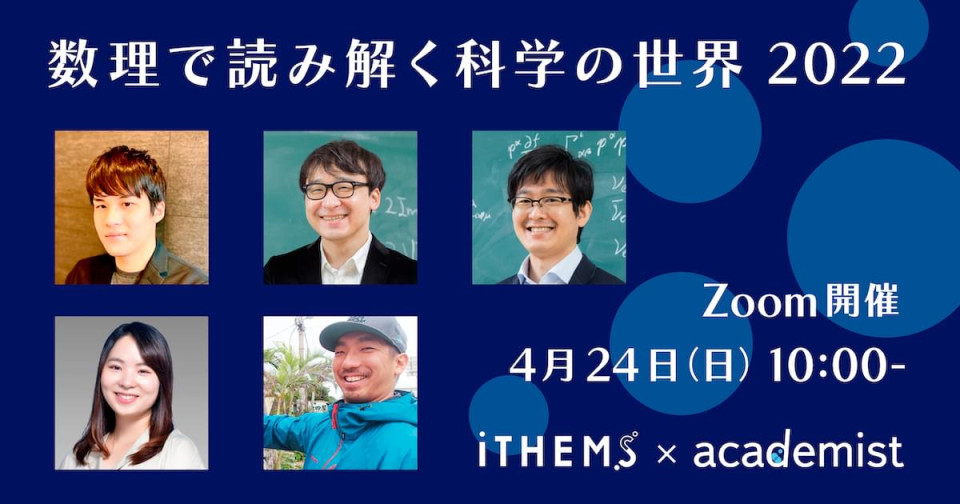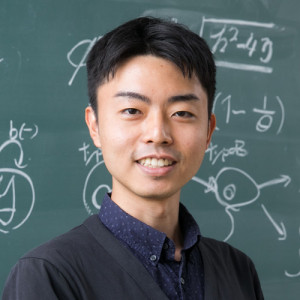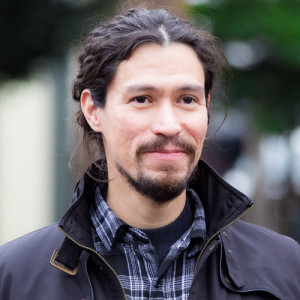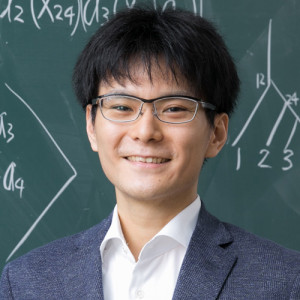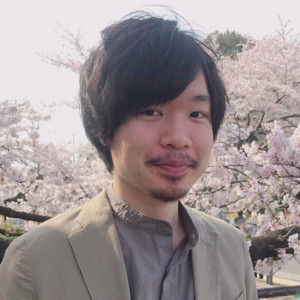Volume 195
Back to Newsletter List
Announcement
Invitation from "Science": "What is Mass? The Fundamental Nature of Matter in the Universe and Its Origin" will be broadcast on Sunday, April 24, on the Open University of Japan (BS 231ch)!
2022-04-18
A four-part series focusing on the fundamental physics concept of "mass" and the historical evolution of its understanding will be broadcast on Sunday, April 24, on the Open University of Japan (BS 231ch).
Tetsuo Hatsuda (Program Director, iTHEMS), Koichi Yazaki (Research Consultant, iTHEMS), and Gordon Baym (Senior Visiting Scientist, iTHEMS) will appear in "Part 4: Do we now know the origin of mass of matter?." The broadcast will air on Sunday, May 15 at 20:15 and Sunday, June 26 at 8:15 (rebroadcast).
For more information, please see the related links.
Upcoming Events
Special Lecture
iTHEMS x academist Online Event "World of Mathematical Sciences 2022"
April 24 (Sun) 10:00 - 16:30, 2022
Masaki Taniguchi (Special Postdoctoral Researcher, RIKEN Interdisciplinary Theoretical and Mathematical Sciences Program (iTHEMS))
Hidetoshi Taya (Special Postdoctoral Researcher, RIKEN Interdisciplinary Theoretical and Mathematical Sciences Program (iTHEMS))
Akira Harada (Special Postdoctoral Researcher, RIKEN Interdisciplinary Theoretical and Mathematical Sciences Program (iTHEMS))
Yingying Xu (Special Postdoctoral Researcher, RIKEN Interdisciplinary Theoretical and Mathematical Sciences Program (iTHEMS))
Euki Yazaki (Postdoctoral Researcher, RIKEN Interdisciplinary Theoretical and Mathematical Sciences Program (iTHEMS))
Venue: via Zoom
Event Official Language: Japanese
Lecture
Introduction to Topological Insulators: From Quantum to Classical Physics 4
April 27 (Wed) 15:00 - 17:00, 2022
Tomoki Ozawa (Associate Professor, Advanced Institute for Materials Research (AIMR), Tohoku University)
In this set of lectures, I give an introduction to topological insulators. A goal is to provide an overall understanding of basic concepts of the physics of topological insulators to mathematicians and physicists with no prior knowledge on the subject. Very roughly speaking, topological insulators are materials whose wavefunctions show nontrivial topological structure in momentum space. Materials with topologically nontrivial wavefunction in momentum space have been found to host modes which are localized at the surface (edge) of the material: a property known as the bulk-edge correspondence. The bulk-edge correspondence results in experimentally observable signature of somewhat abstract notion of topology of the wavefunction in momentum space. Originally, topological insulators were found and studied for electrons in solid-state materials, which are quantum mechanical. However, certain properties of topological insulators, including the bulk-edge correspondence, have been found to hold also for purely classical materials, such as electromagnetic waves obeying Maxwell’s equations, or waves described by Newtonian mechanics. I will try to introduce topological insulators in a way general enough to be applied to quantum as well as classical materials. In the final part of the lectures, I take this opportunity to discuss some of my own works, where I studied some relations between the two-dimensional topological insulators and Kähler geometry.
Venue: via Zoom
Event Official Language: English
Seminar
iTHEMS Biology Seminar
Diversity of Asgardarchaota and Theoretical verification of the endosymbiotic theory
April 28 (Thu) 10:00 - 11:00, 2022
Daiki Kumakura (Ph.D. Student, Graduate School of Life Science, Hokkaido University)
How did intracellular symbiosis occur and give rise to eukaryotic ancestor? This question has been considered to the two theories as three-domain theory and eocyte theory. Here I present asgard archaea, the archaeon closest to eukaryotes. Asgard archaea is an archaeon found at a deep-sea sampling site called Loki's castle at between Greenland and Norway. So all the closely related species are named after Norse mythology (Loki-, Thor-, Odin-, Heimdall-, etc.). Unlike other archaea, asgard archaea has many eukaryotic-specific proteins and is considered to be the closest to eukaryotes. In 2020, one of the asgard archaea species was finally successfully cultured. This archaeon was cultured and found to take on a branch-like structure. It is then hypothesized that intracellular symbiosis between this archaeon and the ancestor of mitochondria resulted in the ancestor of today's eukaryotic cells. In this talk, I would like to discuss with you the explanation of how we arrived at this hypothesis and how to construct a mathematical model.
Venue: via Zoom
Event Official Language: English
Seminar
Quantum Matter Seminar
Introduction to Topological Insulators: Topological Superconductors and Quantum Computing
May 9 (Mon) 14:00 - 15:30, 2022
Ching-Kai Chiu (Senior Research Scientist, RIKEN Interdisciplinary Theoretical and Mathematical Sciences Program (iTHEMS))
References
- A Yu Kitaev, Unpaired Majorana fermions in quantum wires, Phys.-Usp. 44 131 (2001), doi: 10.1070/1063-7869/44/10S/S29
- D. A. Ivanov, Non-Abelian Statistics of Half-Quantum Vortices in p -Wave Superconductors, Phys. Rev. Lett. 86, 268 (2001), doi: 10.1103/PhysRevLett.86.268
Venue: via Zoom
Event Official Language: English
Seminar
Quantum Matter Seminar
Introduction to Topological Insulators: The Ten-fold Classification of Topological Insulators and Superconductors Part.1
May 24 (Tue) 14:00 - 15:30, 2022
Ching-Kai Chiu (Senior Research Scientist, RIKEN Interdisciplinary Theoretical and Mathematical Sciences Program (iTHEMS))
References
- Andreas P. Schnyder, Shinsei Ryu, Akira Furusaki, and Andreas W. W. Ludwig, Classification of topological insulators and superconductors in three spatial dimensions, Phys. Rev. B 78, 195125 (2008), doi: 10.1103/PhysRevB.78.195125
- Alexei Kitaev, Periodic table for topological insulators and superconductors, AIP Conference Proceedings 1134, 22 (2009), doi: 10.1063/1.3149495
Venue: via Zoom
Event Official Language: English
Seminar
NEW WG Seminar
Equilibrium or not? Mathematical differences between acute & chronic virus infections
May 25 (Wed) 13:30 - 15:00, 2022
Catherine Beauchemin (Deputy Program Director, RIKEN Interdisciplinary Theoretical and Mathematical Sciences Program (iTHEMS))
The widely acclaimed 1995/1996 papers by Ho, Perelson and others [1,2] demonstrated the important insights that come from mathematical modelling of virus infection kinetics within a person. But there are key dynamical differences between chronic and acute infections, namely whether the infection reaches or maintains some equilibrium or not. In this talk, I will introduce the equations used to describe a virus infection within a person. I will show some of the tricks used by mathematical modellers to extract important rate estimates from measurements in patients infected with chronic diseases, like HIV or Hepatitis C virus. I will explain why it is difficult to extract meaningful information from measurements in patients with an acute infection, like influenza or possibly COVID-19 [3]. I hope to hear from the audience if they have any thoughts about overcoming the issue to extract better rate information from limited data in patients with acute infections.
(This seminar is a joint seminar between Nonequilibrium working group and Biology study group)
References
- Ho DD, Neumann AU, Perelson AS, Chen W, Leonard JM, Markowitz M., Rapid turnover of plasma virions and CD4 lymphocytes in HIV-1 infection, Nature 373 (6510) 123-6 (1995), doi: 10.1038/373123a0
- Perelson AS, Neumann AU, Markowitz M, Leonard JM, Ho DD, HIV-1 dynamics in vivo: virion clearance rate, infected cell life-span, and viral generation time, Science (1996), doi: 10.1126/science.271.5255.1582
- Palmer J, Dobrovolny HM, and Beauchemin CAA, The in vivo efficacy of neuraminidase inhibitors cannot be determined from the decay rates of influenza viral titers observed in treated patients, Sci. Rep., 7:40210 (2017), doi: doi:10.1038/srep40210
Venue: via Zoom
Event Official Language: English
Upcoming Visitor
April 25 (Mon) - 27 (Wed) 2022 Teiji KunihiroEmeritus Professor, Kyoto University Visiting Place: RIKEN Wako Campus |
Person of the Week
Self-introduction: José Said Gutiérrez-Ortega
2022-04-20
¡Hola! This is José (ホセ). I am a Mexican biologist in search of knowledge and interactions with scientists in all disciplines. I obtained my bachelor's degree in Mexico and completed my graduate studies in Japan: two countries where I grew up as a researcher, and where I also had great experiences working in science education. I joined iTHEMS as a SPDR in April 2022, and this transition represented an extraordinary chance for me to expand my research lines and interests.
My scientific background is in evolutionary biology and ecology. Therefore, the main questions that motivate my studies are “how is the origin of the species?”, “why are species the way they are?”, “why do species change over time?”, “how do species interact with the environment and other species?”. To answer that kind of questions, I have gained abilities in phylogenetics, phylogeography, population genetics, plant systematics, botany, taxonomy, and population ecology. If these prior skills are useful for your research, or if you want to start something completely new, I am always available to work together with you.
よろしくおねがいします!
Person of the Week
Self-introduction: Yuto Moriwaki
2022-04-18
Quantum field theory is a physical theory that describes a wide range of phenomena from the subatomic world to the cosmic scale, and can be regarded as a fruit of human wisdom. However, quantum field theory has not yet been mathematically formulated. This problem perhaps asks us, "How do we formulate space?"
According to the philosophy of algebraic geometry, "space and algebra" are almost the same thing. Here, the algebra is a collection of functions (classical fields). So let us consider the algebra consisting of quantum fields. The "classical algebra" is associative, whereas the "quantum algebra" is non-associative. What should be the corresponding space?
I am currently studying this algebra of quantum fields in the case of two-dimensional quantum field theory. In my previous research, I have worked mathematically on (1) a formulation of the algebra of two-dimensional conformal field theory, (2) constructions of examples, and (3) a construction of non-perturbative deformations. More recently, I have returned to the question of "space" a bit, studying the axioms (consistency) of quantum field theory from a viewpoint of an operad structure of moduli spaces and higher categories.
I was originally a pure mathematician studying representation theory. Crossing the field into physics has been fruitful for my life, although there is still a lot I don't understand. I am very happy to be here at iTHEMS and hope to have good interactions and co-evolution with many researchers.
Person of the Week
Self-introduction: Shou Yoshikawa
2022-04-15
My name is Shou Yoshikawa. I joined RIKEN iTHEMS as an SPDR in April 2022. I am a mathematician studying algebraic geometry. I am interested in an analog of the existence of Kähler-Einstein metric to positive characteristic. Algebraic geometry in positive characteristic is a purely mathematical subject, however, the Einstein metric is deeply related to Physics. I hope that we find a new relation between mathematics and other sciences studying such analogies.
Person of the Week
Self-introduction: Daiki Kumakura
2022-04-15
My name is Daiki Kumakura. I joined iTHEMS as JRA (Junior Research Associate) in April 2022. My research fields are microbial evolutionary ecology and mathematical biology. Still undergraduate, I researched the metabolism of deep marine microbes with transcriptome analysis and comparative genome analysis. Because I am interested in the evolutionary process of microbes with the ecological interactions, I currently have researched the coevolution of microbes with theoretical analysis. Then, I do interdisciplinary research of fieldwork and theoretical simulation. The main field is a hot spring (Japanese is an onsen). I sample the sediments and water at each location and do bioinformatics. In the theoretical analysis, I construct mathematical modeling and simulation.
I have the unique experience of discussing with theoretical researchers in various fields at iTHEMS. Through this interdisciplinary research and discussion, I hope to make my doctoral course meaningful.
Person of the Week
Self-introduction: Taketo Sano
2022-04-15
My name is Taketo Sano. I joined iTHEMS as a special postdoctoral researcher in April 2022 after I got the Ph.D. in mathematical sciences from the University of Tokyo. My research area is in low-dimensional topology and knot theory.
I am interested in the intersection of (or interaction between) topology and combinatorics. Spaces are inherently infinite and beyond direct computations, while their algebraic images (under some nice mappings) are usually more tractable, and in some cases algorithmically computable.
When one finds nice properties in the algebraic level, it is natural to expect that they are reflections of some hidden structures in the spacial level. My aim is to investigate the nature of the unseeable spaces through their algebraic images, by using theoretical tools (from algebraic topology, homotopy theory and category theory) together with computer powers.
Paper of the Week
Week 4, April 2022
2022-04-22
Title: GRB Prompt Emission: Observed Correlations and Their Interpretations
Author: Tyler Parsotan, Hirotaka Ito
arXiv: http://arxiv.org/abs/2204.09729v1
Title: Fedder type criteria for quasi-$F$-splitting
Author: Tatsuro Kawakami, Teppei Takamatsu, Shou Yoshikawa
arXiv: http://arxiv.org/abs/2204.10076v1
If you would like to cancel your subscription or change your email address,
please let us know via our contact form.
Copyright © iTHEMS, RIKEN. All rights reserved.


